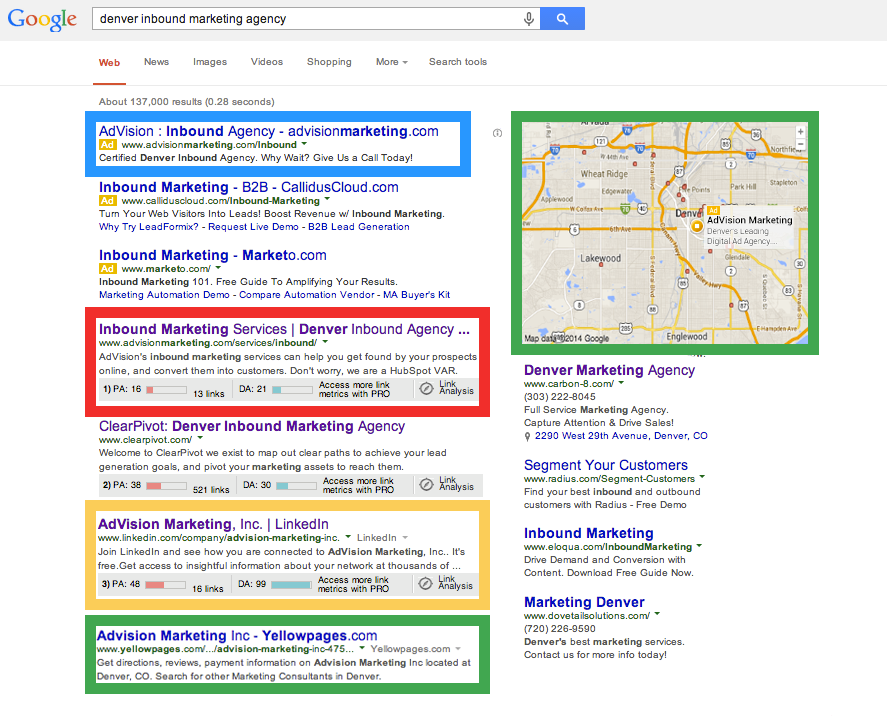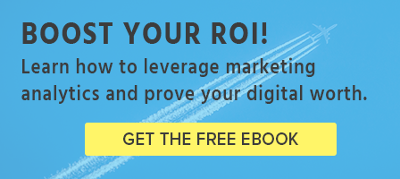How to Capitalize On the Search Landscape

When it comes to traffic generation, the building block of any digital initiative, you need to be savvy in how you reach and engage the highest number of qualified visitors to your website. In terms of the search landscape, and for this purpose, specifically Google search results, searchers should be introduced to as many click-through opportunities as possible. The more “real estate” that your business owns on the first page of Google Search results, the better chance you have of gaining a new visitor.
Below is an image of the typical Google Search result page, specifically a search for ‘denver inbound marketing agency’. Following that, we describe the 4 main elements of the page that we advise businesses capitalize on.

Paid Search (blue) – You may be thinking, “I NEVER click on ads, why would I pay to market my business on Google?
Lets break this down into numbers – 80%-85% of all searchers use Google as their main search tool. Of these searchers, 13%-15% click on ads. This broken out equates to about 6% of all search traffic clicking on Google ads. Seems low right? Possibly even low enough to not be worthy of marketing spend?
Here’s the kicker. BILLIONS of searches happen on a daily basis. In 2013, there was an estimated 5,922,000,000 (yes that’s almost 6 billion searches each day). Lets take 6% again – an estimated 35 million Google ads are clicked each and every day.
Now if you have an extremely niche market that doesn’t get a lot of online searches such as ‘hamster declawing’, PPC may not be worth the time or money. But for any company that provides a product or service of value and wants to find customers online, we suggest utilizing PPC. It doesn’t have to be the main driver of traffic to your website, but it is often an effective supplement to organic traffic generation.
2. Organic Search (red) – People often tell me “I need SEO, but I don’t think I have the budget for it.”
Going back to the numbers, if you want to capture any the 94% of people searching for your products or services online, you MUST be on the first page of results, and as high on the page as possible. It’s honestly as simple as that.
What is unique about Organic Search in comparison to PPC is the cost is mostly upfront. Once you optimize your website structure, build reliable back links and get a content calendar in place, you can start to watch the traffic pour in without consistently allocating marketing dollars to it. To learn more about an effective SEO strategy, view this post.
3. Local Search (green) – Many marketers think, ”This is a huge pain, why waste my time updating profiles on all of these sites?”
There are upwards of one hundred Local Listings websites such as BingLocal, Foursquare, and YellowPages, Filling out all of these profiles are a huge time suck, and they don’t inherently seem to make any measurable difference in terms of digital marketing. What you won’t see with local listings is the offline conversion optimization that they provide, and the back links to your site that improves your site’s SEO. Though some of these sites are no-follow, they still have clout with Google's search algorithm.
Local Listings sites were first created to help searchers find your business’s address, phone number, and hours of operation. These were primarily for businesses that didn’t have websites, so that searchers could find the right information to physically visit a business.
Now that it’s commonplace for businesses to have websites, local listings sites have shifted to be much more robust in providing more business information, photos, bios, calendars, and more.
The noteworthy aspect in which they provide value for this article is by occupying space in the Organic search results for your business, giving your potential visitors another point of possible entry to your site. If you would like a deeper dive into Local Listings, view this post.
4. Social Media (yellow) – We have had many clients say “I don’t have the time to grow a following and to post all day, nor do I have the money to hire for Social Media Marketing.”
Social Media is one of the easiest ways to get qualified traffic back to your site, share your expert content such as blog posts and eBooks, gain backlinks to your website, and engage your following in a more personal manner.
In terms of traffic generation, you can target people who are specifically interested in your brand and industry. In terms of back links and content syndication, these are golden for improving SEO and sharing your content with those who will appreciate it. In terms of the search landscape, Social Media profiles often populate organic search results, giving potential visitors yet another point of entry to your business.
Conclusion
A traffic generation strategy should be a thoughtful and well crafted plan using as many different resources as are available in the digital landscape. These include PPC ads, organic listings, local listings, and social media profiles. By optimizing these avenues, your business will start to see quantity and quality visits.

April 29, 2014

